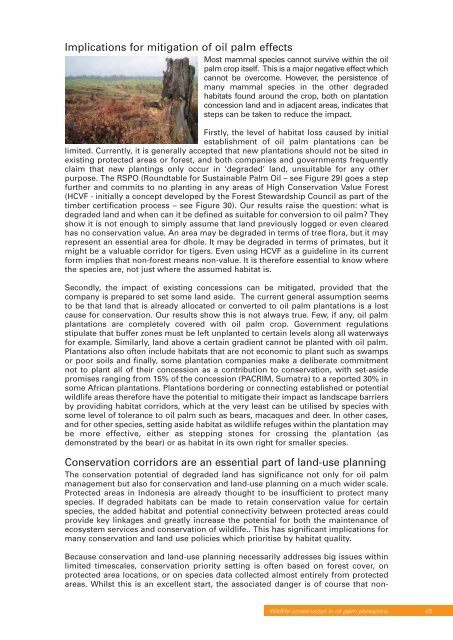The conservation of tigers and other wildlife in oil palm plantations
The conservation of tigers and other wildlife in oil palm plantations
The conservation of tigers and other wildlife in oil palm plantations
Create successful ePaper yourself
Turn your PDF publications into a flip-book with our unique Google optimized e-Paper software.
Implications for mitigation <strong>of</strong> <strong>oil</strong> <strong>palm</strong> effects<br />
Most mammal species cannot survive with<strong>in</strong> the <strong>oil</strong><br />
<strong>palm</strong> crop itself. This is a major negative effect which<br />
cannot be overcome. However, the persistence <strong>of</strong><br />
many mammal species <strong>in</strong> the <strong>other</strong> degraded<br />
habitats found around the crop, both on plantation<br />
concession l<strong>and</strong> <strong>and</strong> <strong>in</strong> adjacent areas, <strong>in</strong>dicates that<br />
steps can be taken to reduce the impact.<br />
Firstly, the level <strong>of</strong> habitat loss caused by <strong>in</strong>itial<br />
establishment <strong>of</strong> <strong>oil</strong> <strong>palm</strong> <strong>plantations</strong> can be<br />
limited. Currently, it is generally accepted that new <strong>plantations</strong> should not be sited <strong>in</strong><br />
exist<strong>in</strong>g protected areas or forest, <strong>and</strong> both companies <strong>and</strong> governments frequently<br />
claim that new plant<strong>in</strong>gs only occur <strong>in</strong> ‘degraded’ l<strong>and</strong>, unsuitable for any <strong>other</strong><br />
purpose. <strong>The</strong> RSPO (Roundtable for Susta<strong>in</strong>able Palm Oil – see Figure 29) goes a step<br />
further <strong>and</strong> commits to no plant<strong>in</strong>g <strong>in</strong> any areas <strong>of</strong> High Conservation Value Forest<br />
(HCVF - <strong>in</strong>itially a concept developed by the Forest Stewardship Council as part <strong>of</strong> the<br />
timber certification process – see Figure 30). Our results raise the question: what is<br />
degraded l<strong>and</strong> <strong>and</strong> when can it be def<strong>in</strong>ed as suitable for conversion to <strong>oil</strong> <strong>palm</strong>? <strong>The</strong>y<br />
show it is not enough to simply assume that l<strong>and</strong> previously logged or even cleared<br />
has no <strong>conservation</strong> value. An area may be degraded <strong>in</strong> terms <strong>of</strong> tree flora, but it may<br />
represent an essential area for dhole. It may be degraded <strong>in</strong> terms <strong>of</strong> primates, but it<br />
might be a valuable corridor for <strong>tigers</strong>. Even us<strong>in</strong>g HCVF as a guidel<strong>in</strong>e <strong>in</strong> its current<br />
form implies that non-forest means non-value. It is therefore essential to know where<br />
the species are, not just where the assumed habitat is.<br />
Secondly, the impact <strong>of</strong> exist<strong>in</strong>g concessions can be mitigated, provided that the<br />
company is prepared to set some l<strong>and</strong> aside. <strong>The</strong> current general assumption seems<br />
to be that l<strong>and</strong> that is already allocated or converted to <strong>oil</strong> <strong>palm</strong> <strong>plantations</strong> is a lost<br />
cause for <strong>conservation</strong>. Our results show this is not always true. Few, if any, <strong>oil</strong> <strong>palm</strong><br />
<strong>plantations</strong> are completely covered with <strong>oil</strong> <strong>palm</strong> crop. Government regulations<br />
stipulate that buffer zones must be left unplanted to certa<strong>in</strong> levels along all waterways<br />
for example. Similarly, l<strong>and</strong> above a certa<strong>in</strong> gradient cannot be planted with <strong>oil</strong> <strong>palm</strong>.<br />
Plantations also <strong>of</strong>ten <strong>in</strong>clude habitats that are not economic to plant such as swamps<br />
or poor s<strong>oil</strong>s <strong>and</strong> f<strong>in</strong>ally, some plantation companies make a deliberate commitment<br />
not to plant all <strong>of</strong> their concession as a contribution to <strong>conservation</strong>, with set-aside<br />
promises rang<strong>in</strong>g from 15% <strong>of</strong> the concession (PACRIM, Sumatra) to a reported 30% <strong>in</strong><br />
some African <strong>plantations</strong>. Plantations border<strong>in</strong>g or connect<strong>in</strong>g established or potential<br />
<strong>wildlife</strong> areas therefore have the potential to mitigate their impact as l<strong>and</strong>scape barriers<br />
by provid<strong>in</strong>g habitat corridors, which at the very least can be utilised by species with<br />
some level <strong>of</strong> tolerance to <strong>oil</strong> <strong>palm</strong> such as bears, macaques <strong>and</strong> deer. In <strong>other</strong> cases,<br />
<strong>and</strong> for <strong>other</strong> species, sett<strong>in</strong>g aside habitat as <strong>wildlife</strong> refuges with<strong>in</strong> the plantation may<br />
be more effective, either as stepp<strong>in</strong>g stones for cross<strong>in</strong>g the plantation (as<br />
demonstrated by the bear) or as habitat <strong>in</strong> its own right for smaller species.<br />
Conservation corridors are an essential part <strong>of</strong> l<strong>and</strong>-use plann<strong>in</strong>g<br />
<strong>The</strong> <strong>conservation</strong> potential <strong>of</strong> degraded l<strong>and</strong> has significance not only for <strong>oil</strong> <strong>palm</strong><br />
management but also for <strong>conservation</strong> <strong>and</strong> l<strong>and</strong>-use plann<strong>in</strong>g on a much wider scale.<br />
Protected areas <strong>in</strong> Indonesia are already thought to be <strong>in</strong>sufficient to protect many<br />
species. If degraded habitats can be made to reta<strong>in</strong> <strong>conservation</strong> value for certa<strong>in</strong><br />
species, the added habitat <strong>and</strong> potential connectivity between protected areas could<br />
provide key l<strong>in</strong>kages <strong>and</strong> greatly <strong>in</strong>crease the potential for both the ma<strong>in</strong>tenance <strong>of</strong><br />
ecosystem services <strong>and</strong> <strong>conservation</strong> <strong>of</strong> <strong>wildlife</strong>.. This has significant implications for<br />
many <strong>conservation</strong> <strong>and</strong> l<strong>and</strong> use policies which prioritise by habitat quality.<br />
Because <strong>conservation</strong> <strong>and</strong> l<strong>and</strong>-use plann<strong>in</strong>g necessarily addresses big issues with<strong>in</strong><br />
limited timescales, <strong>conservation</strong> priority sett<strong>in</strong>g is <strong>of</strong>ten based on forest cover, on<br />
protected area locations, or on species data collected almost entirely from protected<br />
areas. Whilst this is an excellent start, the associated danger is <strong>of</strong> course that non-<br />
Wildlife <strong>conservation</strong> <strong>in</strong> <strong>oil</strong> <strong>palm</strong> <strong>plantations</strong> 45

















